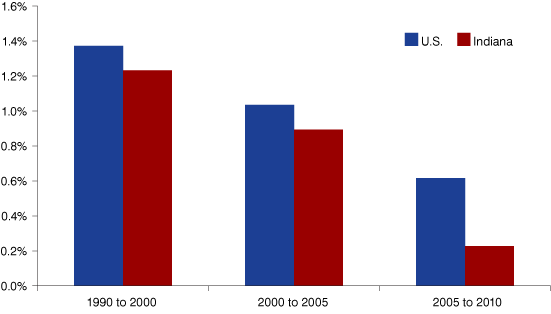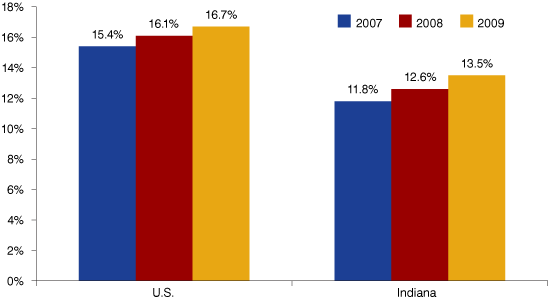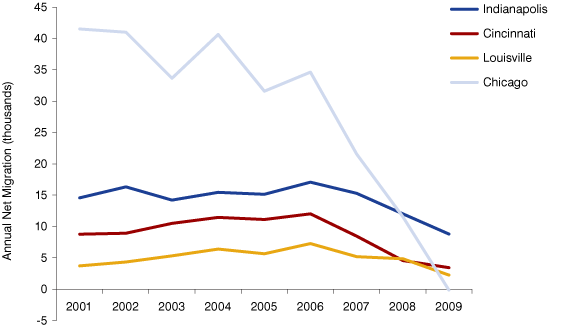A Demographic View of Indiana's Housing Slump
As the U.S. housing slump enters its fifth year, it is easy to become numb to the steady stream of bleak news accounts and statistics. Unfortunately, as many key indicators demonstrate, the housing market shows few signs of turning the corner. And while other states have grabbed the national headlines, the housing downturn continues to dog Indiana as well.
Table 1 shows that Indiana's 2010 existing home sales declined faster than the national average and remained well below peak sales levels seen in 2005. Indiana's house prices continue to fall, though not as quickly as the U.S. average. The state continues to have a large share of mortgages that were seriously delinquent (i.e., 90 days overdue or in foreclosure) and building permit activity is down again after a slight uptick in 2010.
Table 1: Indiana's Housing Market by the Numbers
| Housing Indicator | U.S. | Indiana | Indiana's Rank |
|---|---|---|---|
| Number of Existing Home Sales, Percent Change 2009 to 2010 | -4.8% | -6.7% | 34 |
| House Price Appreciation, 2010:2 to 2011:2* | -6.1% | -4.0% | 19 |
| Value of Residential Building Permits, Percent Change 2010 to 2011** | -1.0% | -5.1% | 25 |
| Share of Mortgages that are Seriously Delinquent , 2011:2 | 7.9% | 8.2% | 9 |
| Share of Mortgages with Negative Equity, 2011:2 | 22.5% | 10.9% | 31 |
* Data are from the FHFA's newly released Expanded House Price Index
**This comparison uses value of permits issued through August of each year
Source: National Association of Realtors, Federal Housing Finance Agency, U.S. Census Bureau, Mortgage Bankers Association and CoreLogic
This article examines the demographic fundamentals of Indiana's housing slump. Stubbornly high unemployment and foreclosure rates, along with general uncertainty in the labor market, have had a dampening effect on many of the demographic drivers of housing demand. For instance, new households are forming at a snail's pace in recent years as more households double up and migration slows. Additionally, homeownership is on the decline, particularly in younger age groups and certain minority populations. A greater rate of household formations, along with stable homeownership rates, will be important factors in a housing rebound.
Household Formations Slow Dramatically
The rate of Indiana's household growth slowed dramatically in the latter part of the last decade. Between 2005 and 2010, the number of households in the state grew by an average rate of 0.2 percent per year compared to 0.9 percent annually in the first half of the decade and 1.2 percent through the 1990s (see Figure 1). These rates translate to a decline from approximately 21,300 new households per year between 2000 and 2005 to 5,600 after. The nation as a whole has had higher rates of household formation yet has seen a similar decline in this measure.
Figure 1: Average Annual Household Formation Rates, U.S. and Indiana, 1990 to 2010

Source: U.S. Census Bureau, Decennial Census and American Community Survey
Several factors have contributed to the decline in household formation. First, economic hardships like unemployment, foreclosure or decreased income may have forced many adults to move-in with family or friends—a process commonly called “ doubling up.” A recent surge in the number of multi-generational households illustrates this trend. According to a recent Pew Research Center analysis of American Community Survey (ACS) data, the share of Indiana residents that lived in multi-generational households increased from nearly 12 percent in 2007 to 13.5 percent in 2009 (see Figure 2).1 These figures translate to a jump from an estimated 749,000 Hoosiers living in multi-generational households in 2007 to 867,000 just two years later—a 16 percent increase.
Figure 2: Share of Population Living in Multi-Generational Households, 2007 to 2009

Source: Pew Research Center, using American Community Survey data
The Pew study suggests that the ability to move in with relatives is providing an important economic safety net for many that are reeling during the downturn. As a case in point, multi-generational households nationwide had a poverty rate of 11.5 percent in 2009 compared to 14.6 percent for all other households.2
Doubling up is also evident in Indiana’s declining headship rates (i.e., the number of households divided by population), particularly among younger age groups. The share of Indiana residents between the ages of 25 and 34 that headed their own household dropped 2.1 percentage points between 2000 and 2010 (see Figure 3). This relatively steep decline for young adults makes sense given that this group has higher unemployment rates than older adults, according to ACS data for Indiana. Headship rates are also down for the 35 to 54 age group, yet slight gains in the population over the age of 65 help to offset some of these losses. To give these figures some context, the state would have roughly 46,500 more households in 2010 had the headship rates held at 2000 levels.
Figure 3: Indiana Headship Rates by Age, 1990 to 2010

Source: U.S. Census Bureau, Decennial Census
A Sharp Decline in Migration
Another factor suppressing household formations is the dramatic decline in migration. This trend has been a key side effect of the most recent economic downturn not only in Indiana but also around the country. The latest population estimates from the Census Bureau show that once booming states like Florida, Arizona and Nevada saw comparatively small population gains through migration in 2009. In the same year, Indiana registered its second-lowest migration figure in nearly two decades, with a net influx of just 2,400 residents from outside the state.
Movement within the state is also down as the slumping housing market and employment insecurity forced many potential movers to sit tight. This is particularly true among homeowners. Data from the ACS shows that the share of Hoosier homeowners that reported moving within the state over the previous year declined from 7 percent in 2005 to 5.6 percent in 2009. Dampened mobility within Indiana along with low levels of migration from elsewhere has meant that many fast-growing communities saw far fewer new residents than usual toward the end of the last decade. This is most evident in the suburbs of large metro areas.
Figure 4: Net Migration in Suburban Counties of Select Metro Areas, 2001 to 2009

Source: U.S. Census Bureau Population Estimates
Figure 4 illustrates the annual net migration for the suburban counties of the Indianapolis metro area along with the large metros that border the state.3 According to Census population estimates, the nine suburban counties of the Indianapolis area averaged a net in-migration of roughly 15,400 residents a year between 2001 and 2007. However, the net influx dropped to 12,000 in 2008 and 8,800 in 2009. Within the area, Hamilton County had the largest drop—going from an annual average of 7,600 net in-migrants between 2001 and 2007 to 5,200 in 2009. Comparing the same periods, the net in-migration marks for Hendricks and Johnson counties were down 1,600 residents and 1,200 residents, respectively.
The outlying counties of the Chicago metro area (which include Lake, Porter, Jasper and Newton counties in Indiana) have shown an even more dramatic fall in migration. These 13 counties combined to average a net in-migration of 35,000 residents a year between 2001 and 2007 yet had a slight net out-migration in 2009. Of this group, Indiana’s Lake County had the largest 2009 net out-migration at nearly 1,600 residents. Overall, migration to Louisville’s suburbs was down too, yet Indiana’s Clark and Floyd counties bucked the broader trend as their net influx in 2009 outpaced their average from earlier in the decade.
Homeownership in Retreat
The rate of household formation is down but this trend should improve when the economy does. A 2010 study indicated that a 2 percentage point drop in the U.S. unemployment rate between 2010 and 2012 would increase the nation’s household formations by 2 percentage points over the same period.4 But will these new households be looking to buy at the same levels seen prior to the housing crash or will they continue to tilt more heavily toward the rental market? Given tighter lending standards, the continued fallout from the foreclosure crisis and lagging incomes in Indiana, the latter seems more likely.
Indiana’s homeownership rate has already dropped precipitously since the onset of the housing slump. Data from the Census Bureau’s Housing Vacancy Survey indicate that after a dramatic climb in homeownership beginning in the mid 1990s that was fueled by easier access to credit and the aging of the baby boom generation, the state’s homeownership rate plunged 3 percentage points between 2008 and 2010. According to the 2010 Census, the state’s homeownership rate now stands at 69.9 percent, which is below the mark measured in 1990 (70.2 percent) and 2000 (71.4 percent).
Indiana’s overall rate in 2010 masks what is an even more dramatic fall in homeownership. Under normal conditions, Indiana’s homeownership rate would have risen simply because the state is growing older and homeownership increases with age. Baby boomers are now between the ages of 45 and 65, meaning that this age group holds a larger share of the state’s population than ever before. This expansion of the prime homeownership age group tends to boost the rate, even if age-specific homeownership rates are down.
And Indiana’s age-specific homeownership rates are down significantly. The homeownership rates for each 10-year age group between the ages of 25 and 54 are down roughly 4.5 percentage points when compared to the 2000 Census (see Figure 5). The homeownership rate for the 55 to 64 age group was down 2.9 percentage points to 81.3 percent while the share of Indiana seniors that owned their home increased slightly to 80.6 percent. These data underscore the toll that the spike in foreclosures and the economic downturn have taken on homeownership.
Figure 5: Indiana Homeownership Rates by Age, 1990 to 2010

Source: U.S. Census Bureau
Another factor that could continue to tilt the balance between homeownership and renting is Indiana’s increasing racial and ethnic diversity. Over the last decade, an additional 175,000 Hispanic residents called Indiana home—an 82 percent increase. The state’s black population grew by nearly 77,000 while the number of white residents increased by 67,000.5 With these different growth rates, Indiana’s white population went from 86 percent of the state’s total in 2000 to 82 percent in 2010. Meanwhile, the state’s black and Hispanic populations now account for 9 percent and 6 percent of the total, respectively.
These are meaningful shifts considering that housing trends vary widely by race and ethnicity in Indiana. For instance, the homeownership rate for Indiana’s white householders is 74 percent (see Figure 6). By contrast, 52 percent of the state’s Hispanic households own their homes and just 41 percent of black households are owner-occupied.
Figure 6: Indiana Population Change and Homeownership Rates by Race and Ethnicity, 2000 to 2010

Source: U.S. Census Bureau
Wide income disparities certainly play a large role in the different rates of homeownership. The 2010 median household income for Indiana’s white population was $47,200 compared to $33,200 for Hispanic households. The median household income for Indiana’s black households was $30,000. Clearly, economic development and improved educational outcomes will be critical to closing the gaps in income and homeownership.
One hopeful sign that this gap could already be closing is the improved homeownership rate of Indiana’s Hispanic population. Between 2000 and 2010, the state’s Hispanic homeownership rate increased by nearly four percentage points. Unfortunately, the experience for Indiana’s black population has been far different. In 2000, 45.2 percent of Indiana’s black householders owned their home but this mark dropped to 40.6 percent by 2010. The homeownership rate for Indiana’s white population also declined slightly over the decade.
Conclusion
It may well be appropriate that more Hoosiers look to rent and that Indiana’s homeownership rate settles at a more sustainable level. However, the combined effects of the decline in household formation, migration and homeownership have implications for the broader economy. Residential fixed investment (RFI), which tends to be a key leading indicator for the economy, has yet to contribute consistently to the nation’s economic recovery. In fact, since 1950, RFI has accounted for 4.7 percent of U.S. GDP on average. As housing demand has nosedived, however, RFI’s share of economic activity stood at just 2.3 percent in 2010—the lowest annual mark since the end of World War II.
The pieces are in place for a housing recovery. Homes have rarely been more affordable and mortgage interest rates are at historic lows. During a more typical economic slump, these conditions would likely help to spur an economic recovery but the opposite is true this time. Given housing’s central role in this downturn, it appears that only a sustained recovery in other areas of the economy will stoke the demographic drivers of housing demand.
Notes
- For its report, the Pew Research Center defined multi-generational households as a household that includes a parent and an adult child (age 25 or older), three or more generations living together, or grandparents raising grandchildren alone.
- "Fighting Poverty in a Tough Economy, Americans Move in with Their Relatives," Pew Research Center, October 2011, https://www.pewresearch.org/social-trends/2011/10/03/fighting-poverty-in-a-bad-economy-americans-move-in-with-relatives/.
- In the case of the Indianapolis metro area, the suburban counties are Boone, Brown, Hamilton, Hancock, Hendricks, Johnson, Morgan, Putnam and Shelby. Marion County is the metro area's core county and is excluded from these numbers. Many of the Midwest's core metro counties—Marion County included—saw marked improvements in their net migration figures through the downturn as the flow of residents to suburban areas or to other fast-growing regions of the country slowed.
- Gary Painter,“What Happens to Household Formation in a Recession?”, Research Institute for Housing America, April 2010.
- The term Hispanic refers to an ethnicity and not a race so Hispanic residents can be of any race. The figures reported for specific race groups in this section exclude the Hispanic residents of that race. Therefore, figures for the state's white population, for example, refer to non-Hispanic white residents.
Matt Kinghorn
Demographer, Indiana Business Research Center, Indiana University Kelley School of Business
